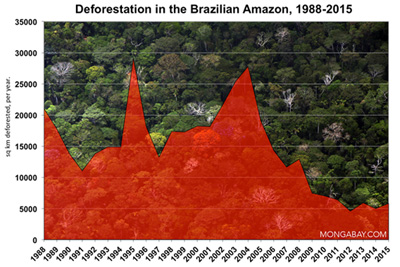Brazil will forge its own path for developing the Amazon
Brazil will forge its own path for developing the Amazon
mongabay.com
May 15, 2008
|
|
The Brazilian government will use cheap loans, payments, and other benefits to encourage Amazon farmers to reduce their impact on the Amazon rainforest, under a plan unveiled last week.
Brazil says the Sustainable Amazon Plan will create jobs, generate economic growth and reduce social inequalities for the more than 23 million people living in the Amazon by promoting sustainable development schemes and improving infrastructure to integrate the region into the broader economy. Critics say the plan’s emphasis on port and road expansion will facilitate more deforestation — Environment Minister Marina Silva resigned shortly after the plan was announced.
Own path
Speaking at a ceremony introducing the plan, Brazilian President Luiz Inacio Lula da Silva said that Brazil will forge its own path to developing the Amazon.
“There are people who think the Amazon should belong to mankind. And we think that way, too. We think that it needs to benefit everyone. But we also have to say loudly and clearly that it is Brazil that is in charge of looking after the Amazon,” Lula said.
“Each time someone talks about the Amazon abroad, usually it provokes a defense, responses to questions about deforestation, burning of land, pollution and other things that we raise. We often have a lot of problems with that.”
Lula’s comments came shortly after Brazil announced it would crack down on foreign environmental groups working in the Amazon region.
Cheap loans and other incentives to discourage forest clearing
 Deforestation in the Brazilian Amazon fell by more than 60 percent between 2004 and 2007, but increased in the second half of 2007. |
The new initiative establishes a 1-billion-real ($600 million) fund for farmers who adopt environmentally-friendly farming methods. The farmers are eligible for loans at 4 percent annual interest, well below the country’s benchmark rate of 11.75 percent, and follows up on a December presidential decree banning the sale of farm products from illegally deforested areas in the Amazon. The new plan offers social security, unemployment benefits, and job training to 40,000 families once involved in logging and will create a landholder registry to counter illegal occupation of public forest land and improve governance in the region.
Addressing governance
While Brazil already has some of the toughest environmental regulations in the world — by law 80 percent of a landowner’s property must be left forested — these rules are haphazardly enforced in the Amazon. A slow approvals process — for permits ranging from scientific research to development — has been blamed for fueling endemic corruption and a “Wild West” mentality in the region.
The new plan seeks address some of these issues by offering financial incentives for environmental performance as well as establishing mechanisms for tracking ownership of land. Still it will be difficult to overcome the broader trends that are driving the destruction of the Amazon rainforest.
Growing agricultural production in the Amazon means that commodity prices are increasingly linked with forest clearing. As grain and beef prices surged in the second half of 2007, so did deforestation: after a three-year decline in forest loss, deforestation rates more than doubled between August 2007 and the end of the year.
Related articles
Brazil cracks down on illegal soy, cattle production in the Amazon December 24, 2007
The Brazilian government launched a new initiative to slow deforestation in the Amazon, setting the stage for the country to potentially earn billions from carbon trading schemes set in motion two weeks ago at the U.N. climate meeting in Bali.
Can cattle ranchers and soy farmers save the Amazon? June 7, 2007
The key to making conservation successful is making it profitable. John Carter may hold that key. Since the early 1970s, environmental groups have spent billions of dollars on conservation efforts in the Amazon, but have failed to slow the destruction of its rainforests — the Brazilian Amazon has lost more than 700,000 square kilometers (270,000 square miles) of forest in that time. As donor dollars poured into the region, deforestation rates continued to climb, peaking at 73,785 square kilometers (28,488 sq mi) of forest loss between 2002 and 2004, before falling sharply in 2005 and 2006 due to declining commodity prices. To many, it’s become apparent that the market, not conservation measures, will determine the fate of the Amazon.
Amazon rainforest at a tipping point, but globalization could help save it June 4, 2007
Despite its scale — the basin covers 40 percent of South America — the Amazon is also one of the fastest changing ecosystems, largely as a result of human activities, including deforestation, forest fires, and, increasingly, climate change. Few people understand these impacts better than Dr. Daniel Nepstad. Nepstad suggests that globalization — the economic force long demonized by some environmentalists — may be fostering new priorities among producers of agricultural commodities in the Amazon. In a 2006 paper published in Conservation Biology, Nepstad and his colleagues argued that the Amazon beef and soybean industries, the primary drivers of Amazon deforestation, “are increasingly responsive to economic signals emanating from around the world.”